Efficient Adsorption of Ammonia by Surface-Modified Activated Carbon Fiber Mesh
Abstract
:1. Introduction
2. Materials and Methods
2.1. Materials
2.2. Preparation of the Adsorbents
2.3. Characterization
2.4. Measurement of Ammonia Adsorption Isotherms
2.5. Adsorption Equilibrium and Heat of Adsorption
2.6. Adsorption Dynamics
3. Results and Discussion
3.1. Physical Properties
3.2. Surface Chemistry
3.3. Adsorption Equilibrium and Heat of Adsorption
3.3.1. Ammonia Adsorption Isotherm Experiments
3.3.2. Modelling of Ammonia Adsorption Equilibrium Isotherms
3.3.3. Equivalent Heat of Adsorption and Thermodynamic Parameters
3.4. Ammonia Adsorption
3.4.1. Breakthrough Tests
3.4.2. Ammonia Adsorption in Gas Streams with Different Moisture Contents
3.5. Correlation between Surface Functional Groups and Capacity
4. Conclusions
Supplementary Materials
Author Contributions
Funding
Acknowledgments
Conflicts of Interest
References
- Wang, G.; Zhang, R.; Gomez, M.E.; Yang, L.; Levy Zamora, M.; Hu, M.; Lin, Y.; Peng, J.; Guo, S.; Meng, J.; et al. Persistent Sulfate Formation from London Fog to Chinese Haze. Proc. Natl. Acad. Sci. USA 2016, 113, 13630–13635. [Google Scholar] [CrossRef]
- Petit, C.; Karwacki, C.; Peterson, G.; Bandosz, T.J. Interactions of Ammonia with the Surface of Microporous Carbon Impregnated with Transition Metal Chlorides. J. Phys. Chem. C 2007, 111, 12705–12714. [Google Scholar] [CrossRef]
- Committee on Acute Exposure Guideline Levels; Committee on Toxicology; Board on Environmental Studies and Toxicology; Division on Earth and Life Studies; National Research Council. Acute Exposure Guideline Levels for Selected Airborne Chemicals: Volume 16; National Academies Press (US): Washington, DC, USA, 2014; ISBN 978-0-309-30096-4.
- Viatte, C.; Abeed, R.; Yamanouchi, S.; Porter, W.C.; Safieddine, S.; Van Damme, M.; Clarisse, L.; Herrera, B.; Grutter, M.; Coheur, P.-F.; et al. NH3 Spatiotemporal Variability over Paris, Mexico City, and Toronto, and Its Link to PM2.5 during Pollution Events. Atmos. Chem. Phys. 2022, 22, 12907–12922. [Google Scholar] [CrossRef]
- Kong, L.; Tang, X.; Zhu, J.; Wang, Z.; Pan, Y.; Wu, H.; Wu, L.; Wu, Q.; He, Y.; Tian, S.; et al. Improved Inversion of Monthly Ammonia Emissions in China Based on the Chinese Ammonia Monitoring Network and Ensemble Kalman Filter. Environ. Sci. Technol. 2019, 53, 12529–12538. [Google Scholar] [CrossRef] [PubMed]
- Liu, J.-X.; Dai, F.; Mao, N. Effect of Acid-Base Interaction Corrosion on Properties of Aramid Filter. Dongbei Daxue Xuebao/J. Northeast. Univ. 2023, 44, 1034–1040. [Google Scholar]
- Vainio, E.; Yrjas, P.; Hupa, L.; Hupa, M. Cold-End Corrosion Caused by Hygroscopic Ammonium Chloride in Thermal Conversion of Biomass and Waste. Fuel 2023, 346, 128061. [Google Scholar] [CrossRef]
- Berhe Gebreegziabher, T.; Wang, S.; Nam, H. Adsorption of H2S, NH3 and TMA from Indoor Air Using Porous Corncob Activated Carbon: Isotherm and Kinetics Study. J. Environ. Chem. Eng. 2019, 7, 103234. [Google Scholar] [CrossRef]
- Ouyang, W.; Zheng, S.; Wu, C.; Hu, X.; Chen, R.; Zhuo, L.; Wang, Z. Dynamic Ammonia Adsorption by FAU Zeolites to below 0.1 Ppm for Hydrogen Energy Applications. Int. J. Hydrogen Energy 2021, 46, 32559–32569. [Google Scholar] [CrossRef]
- Huang, C.-C.; Li, H.-S.; Chen, C.-H. Effect of Surface Acidic Oxides of Activated Carbon on Adsorption of Ammonia. J. Hazard. Mater. 2008, 159, 523–527. [Google Scholar] [CrossRef]
- Moribe, S.; Chen, Z.; Alayoglu, S.; Syed, Z.H.; Islamoglu, T.; Farha, O.K. Ammonia Capture within Isoreticular Metal–Organic Frameworks with Rod Secondary Building Units. ACS Mater. Lett. 2019, 1, 476–480. [Google Scholar] [CrossRef]
- Li, J.; Yang, S.; Du, Z.; Wang, R.; Yuan, L.; Wang, H.; Wu, Z. Quantitative Analysis of Ammonia Adsorption in Ag/AgI-Coated Hollow Waveguide by Mid-Infrared Laser Absorption Spectroscopy. Opt. Lasers Eng. 2019, 121, 80–86. [Google Scholar] [CrossRef]
- Seredych, M.; Bandosz, T.J. Graphite Oxide/AlZr Polycation Composites: Surface Characterization and Performance as Adsorbents of Ammonia. Mater. Chem. Phys. 2009, 117, 99–106. [Google Scholar] [CrossRef]
- Kumari, M.; Chaudhary, G.R.; Chaudhary, S.; Umar, A. Transformation of Solid Plastic Waste to Activated Carbon Fibres for Wastewater Treatment. Chemosphere 2022, 294, 133692. [Google Scholar] [CrossRef]
- Xu, Y.; Chen, Y.; Ma, C.; Qiao, W.; Wang, J.; Ling, L. Functionalization of Activated Carbon Fiber Mat with Bimetallic Active Sites for NH3 and H2S Adsorption at Room Temperature. Sep. Purif. Technol. 2022, 303, 122335. [Google Scholar] [CrossRef]
- Díez, N.; Álvarez, P.; Granda, M.; Blanco, C.; Santamaría, R.; Menéndez, R. A Novel Approach for the Production of Chemically Activated Carbon Fibers. Chem. Eng. J. 2015, 260, 463–468. [Google Scholar] [CrossRef]
- Ko, T.-H.; Chiranairadul, P.; Lu, C.-K.; Lin, C.-H. The Effects of Activation by Carbon Dioxide on the Mechanical Properties and Structure of PAN-Based Activated Carbon Fibers. Carbon 1992, 30, 647–655. [Google Scholar] [CrossRef]
- Chen, B.-C.; Tsai, C.-Y.; Pan, S.-Y.; Chen, Y.-T.; Hsi, H.-C. Sustainable Recovery of Gaseous Mercury by Adsorption and Electrothermal Desorption Using Activated Carbon Fiber Cloth. Environ. Sci. Technol. 2020, 54, 1857–1866. [Google Scholar] [CrossRef] [PubMed]
- Liu, Y.; Mallouk, K.; Emamipour, H.; Rood, M.J.; Liu, X.; Yan, Z. Isobutane Adsorption with Carrier Gas Recirculation at Different Relative Humidities Using Activated Carbon Fiber Cloth and Electrothermal Regeneration. Chem. Eng. J. 2019, 360, 1011–1019. [Google Scholar] [CrossRef]
- Economy, J.; Daley, M.; Mangun, C. Activated Carbon Fibers—Past, Present and Future. In Preprints of Papers, American Chemical Society, Division of Fuel Chemistry, Proceedings of the Spring National Meeting of the American Chemical Society (ACS), New Orleans, LA, USA, 24–28 March 1996; Office of Scientific and Technical Information: Oak Ridge, TN, USA, 1996; Volume 41. [Google Scholar]
- Ye, L.; Lo, B.T.W.; Qu, J.; Wilkinson, I.; Hughes, T.; Murray, C.A.; Tang, C.C.; Tsang, S.C.E. Probing Atomic Positions of Adsorbed Ammonia Molecules in Zeolite. Chem. Commun. 2016, 52, 3422–3425. [Google Scholar] [CrossRef]
- Han, B.; Butterly, C.; Zhang, W.; He, J.; Chen, D. Adsorbent Materials for Ammonium and Ammonia Removal: A Review. J. Clean. Prod. 2021, 283, 124611. [Google Scholar] [CrossRef]
- Seredych, M.; Petit, C.; Tamashausky, A.V.; Bandosz, T.J. Role of Graphite Precursor in the Performance of Graphite Oxides as Ammonia Adsorbents. Carbon 2009, 47, 445–456. [Google Scholar] [CrossRef]
- Bandosz, T.J. Towards Understanding Reactive Adsorption of Small Molecule Toxic Gases on Carbonaceous Materials. Catal. Today 2012, 186, 20–28. [Google Scholar] [CrossRef]
- Qajar, A.; Peer, M.; Andalibi, M.R.; Rajagopalan, R.; Foley, H.C. Enhanced Ammonia Adsorption on Functionalized Nanoporous Carbons. Microporous Mesoporous Mater. 2015, 218, 15–23. [Google Scholar] [CrossRef]
- Zheng, W.; Hu, J.; Rappeport, S.; Zheng, Z.; Wang, Z.; Han, Z.; Langer, J.; Economy, J. Activated Carbon Fiber Composites for Gas Phase Ammonia Adsorption. Microporous Mesoporous Mater. 2016, 234, 146–154. [Google Scholar] [CrossRef]
- Saha, D.; Grappe, H.A. 5—Adsorption Properties of Activated Carbon Fibers. In Activated Carbon Fiber and Textiles; Chen, J.Y., Ed.; Woodhead Publishing Series in Textiles; Woodhead Publishing: Oxford, UK, 2017; pp. 143–165. ISBN 978-0-08-100660-3. [Google Scholar]
- Zheng, C.; Song, H.; Xie, Y.; Yang, X.; Lan, L.; Kang, K.; Bai, S. Modeling of Multi-Temperature IV and V-Type Water Vapor Adsorption Isotherms on Activated Carbons for Chemical Protection. Colloids Surf. A Physicochem. Eng. Asp. 2023, 670, 131486. [Google Scholar] [CrossRef]
- Zheng, C.; Kang, K.; Xie, Y.; Yang, X.; Lan, L.; Song, H.; Bai, S. Competitive Adsorption and Selectivity of Water Vapor/R134a on Activated Carbon for Indoor Air Purification. Sep. Purif. Technol. 2023, 317, 123741. [Google Scholar] [CrossRef]
- Corre, Y.; Seredych, M.; Bandosz, T.J. Analysis of the Chemical and Physical Factors Affecting Reactive Adsorption of Ammonia on Graphene/Nanoporous Carbon Composites. Carbon 2013, 55, 176–184. [Google Scholar] [CrossRef]
- Jiménez, V.; Sánchez, P.; Romero, A. 2—Materials for Activated Carbon Fiber Synthesis. In Activated Carbon Fiber and Textiles; Chen, J.Y., Ed.; Woodhead Publishing Series in Textiles; Woodhead Publishing: Oxford, UK, 2017; pp. 21–38. ISBN 978-0-08-100660-3. [Google Scholar]
- Shan, X.; Zhu, S.; Zhang, W. Effect of Surface Modification of Activated Carbon on Its Adsorption Capacity for NH3. J. China Univ. Min. Technol. 2008, 18, 261–274. [Google Scholar] [CrossRef]
- Huang, Y.; Yu, Q.; Li, M.; Jin, S.; Fan, J.; Zhao, L.; Yao, Z. Surface Modification of Activated Carbon Fiber by Low-Temperature Oxygen Plasma: Textural Property, Surface Chemistry, and the Effect of Water Vapor Adsorption. Chem. Eng. J. 2021, 418, 129474. [Google Scholar] [CrossRef]
- Jansen, R.J.J.; van Bekkum, H. XPS of Nitrogen-Containing Functional Groups on Activated Carbon. Carbon 1995, 33, 1021–1027. [Google Scholar] [CrossRef]
- Figueiredo, J.L.; Pereira, M.F.R.; Freitas, M.M.A.; Órfão, J.J.M. Modification of the Surface Chemistry of Activated Carbons. Carbon 1999, 37, 1379–1389. [Google Scholar] [CrossRef]
- Li, Q.; Hou, Y.; Wang, J.; Liu, Y.; Xiang, N.; Huang, Z. Superiority of Raw Biomass and Potassium Hydroxide in Preparation of Ultrahigh Nitrogen Doping of Carbon for NH3-SCR Reaction. ACS Sustain. Chem. Eng. 2020, 8, 11308–11316. [Google Scholar] [CrossRef]
- Fanning, P.E.; Vannice, M.A. A DRIFTS Study of the Formation of Surface Groups on Carbon by Oxidation. Carbon 1993, 31, 721–730. [Google Scholar] [CrossRef]
- Grassie, N.; McGuchan, R. Pyrolysis of Polyacrylonitrile and Related Polymers—VI. Acrylonitrile Copolymers Containing Carboxylic Acid and Amide Structures. Eur. Polym. J. 1972, 8, 257–269. [Google Scholar] [CrossRef]
- Cardenas, C.; Sigot, L.; Vallières, C.; Marsteau, S.; Marchal, M.; Latifi, A.M. Ammonia Capture by Adsorption on Doped and Undoped Activated Carbon: Isotherm and Breakthrough Curve Measurements. Sep. Purif. Technol. 2023, 313, 123454. [Google Scholar] [CrossRef]
- Chen, Y.; Shan, B.; Yang, C.; Yang, J.; Li, J.; Mu, B. Environmentally Friendly Synthesis of Flexible MOFs M(NA)2 (M = Zn, Co, Cu, Cd) with Large and Regenerable Ammonia Capacity. J. Mater. Chem. A 2018, 6, 9922–9929. [Google Scholar] [CrossRef]
- Wang, J.; Jiang, W.; Zhang, Z.; Long, D. Mesoporous Carbon Beads Impregnated with Transition Metal Chlorides for Regenerative Removal of Ammonia in the Atmosphere. Ind. Eng. Chem. Res. 2017, 56, 3283–3290. [Google Scholar] [CrossRef]
- Cao, Z.; Cai, X.; Feltrin, A.C.; Feng, P.; Kaiser, A.; Akhtar, F. Calcium/Strontium Chloride Impregnated Zeolite A and X Granules as Optimized Ammonia Sorbents. RSC Adv. 2022, 12, 35115–35122. [Google Scholar] [CrossRef]
- Fan, R.; Chen, C.; Lin, J.; Tzeng, J.; Huang, C.; Dong, C.; Huang, C.P. Adsorption Characteristics of Ammonium Ion onto Hydrous Biochars in Dilute Aqueous Solutions. Bioresour. Technol. 2019, 272, 465–472. [Google Scholar] [CrossRef] [PubMed]
- Silva, I.F.; Teixeira, I.F.; Barros, W.P.; Pinheiro, C.B.; Ardisson, J.D.; Do Nascimento, G.M.; Pradie, N.A.; Teixeira, A.P.C.; Stumpf, H.O. An FeIII Dinuclear Metallacycle Complex as a Size-Selective Adsorbent for Nitrogenous Compounds and a Potentially Effective Ammonia Storage Material. J. Mater. Chem. A 2019, 7, 15225–15232. [Google Scholar] [CrossRef]
- De Franco, M.A.E.; De Carvalho, C.B.; Bonetto, M.M.; De Pelegrini Soares, R.; Féris, L.A. Diclofenac Removal from Water by Adsorption Using Activated Carbon in Batch Mode and Fixed-Bed Column: Isotherms, Thermodynamic Study and Breakthrough Curves Modeling. J. Clean. Prod. 2018, 181, 145–154. [Google Scholar] [CrossRef]
- Canals-Batlle, C.; Ros, A.; Lillo-Ródenas, M.; Fuente, E.; Morán, M.; Martin, M.; Linares-Solano, A. Carbonaceous Adsorbents for NH3 Removal at Room Temperature. Carbon 2008, 46, 176. [Google Scholar] [CrossRef]
- Lan, L.; Yang, X.; Kang, K.; Song, H.; Xie, Y.; Zhou, S.; Liang, Y.; Bai, S. Fabrication of PA-PEI-MOF303(Al) by Stepwise Impregnation Layer-by-Layer Growth for Highly Efficient Removal of Ammonia. Nanomaterials 2023, 13, 727. [Google Scholar] [CrossRef]
- Le Leuch, L.M.; Bandosz, T.J. The Role of Water and Surface Acidity on the Reactive Adsorption of Ammonia on Modified Activated Carbons. Carbon 2007, 45, 568–578. [Google Scholar] [CrossRef]
- Zhu, F.; Wang, Z.; Huang, J.; Hu, W.; Xie, D.; Qiao, Y. Efficient Adsorption of Ammonia on Activated Carbon from Hydrochar of Pomelo Peel at Room Temperature: Role of Chemical Components in Feedstock. J. Clean. Prod. 2023, 406, 137076. [Google Scholar] [CrossRef]
- Travlou, N.A.; Bandosz, T.J. N-Doped Polymeric Resin-Derived Porous Carbons as Efficient Ammonia Removal and Detection Media. Carbon 2017, 117, 228–239. [Google Scholar] [CrossRef]
- Sun, D.; Liu, Q.; Liu, Z.; Gui, G.; Huang, Z. Adsorption and Oxidation of NH3 over V2O5/AC Surface. Appl. Catal. B Environ. 2009, 92, 462–467. [Google Scholar] [CrossRef]
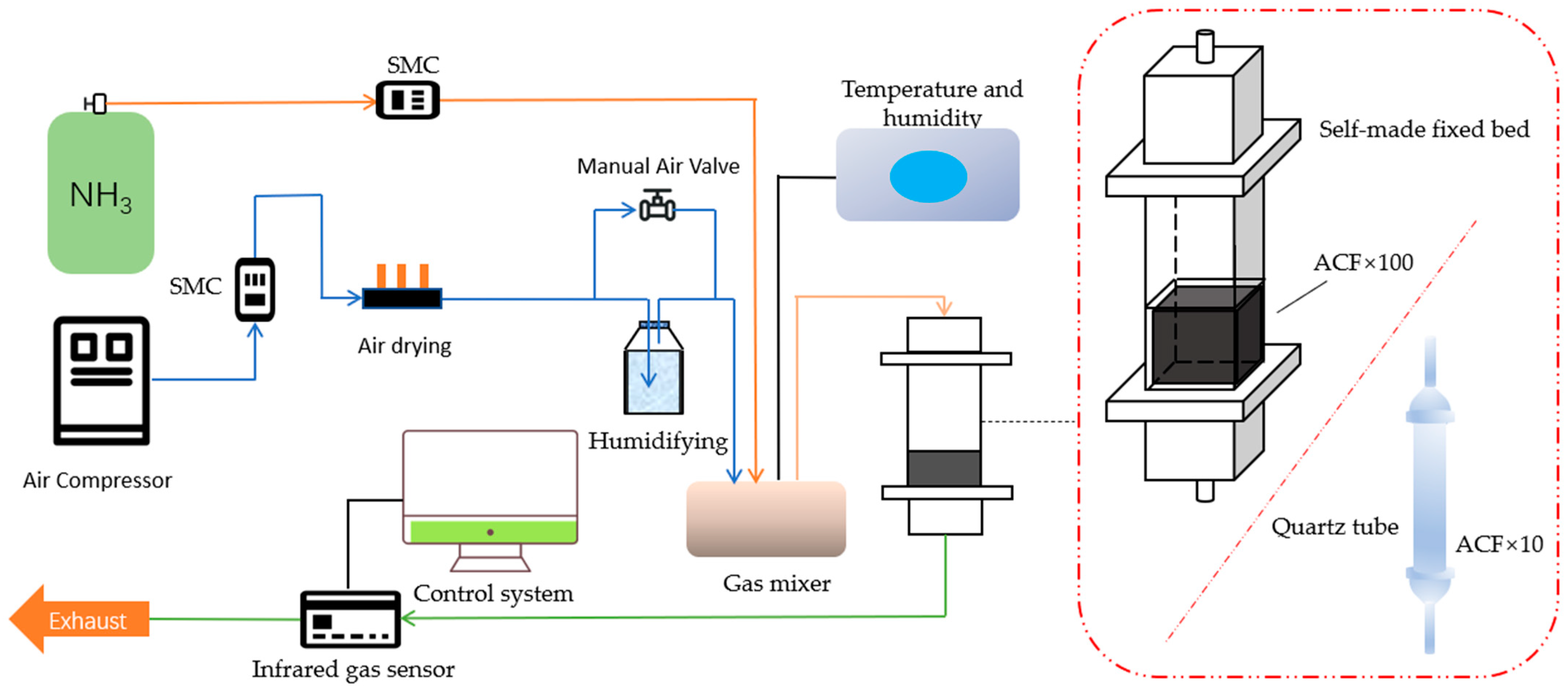
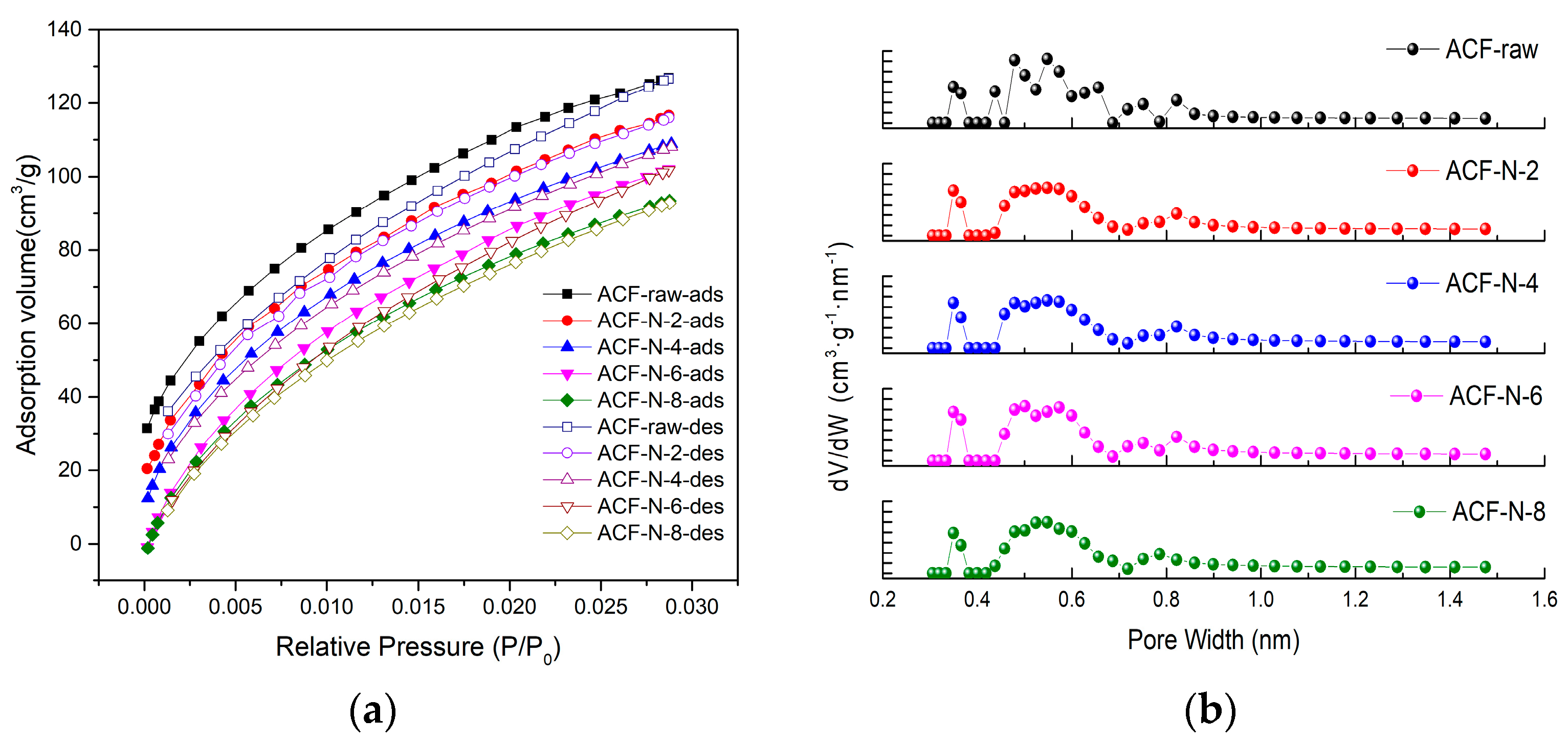
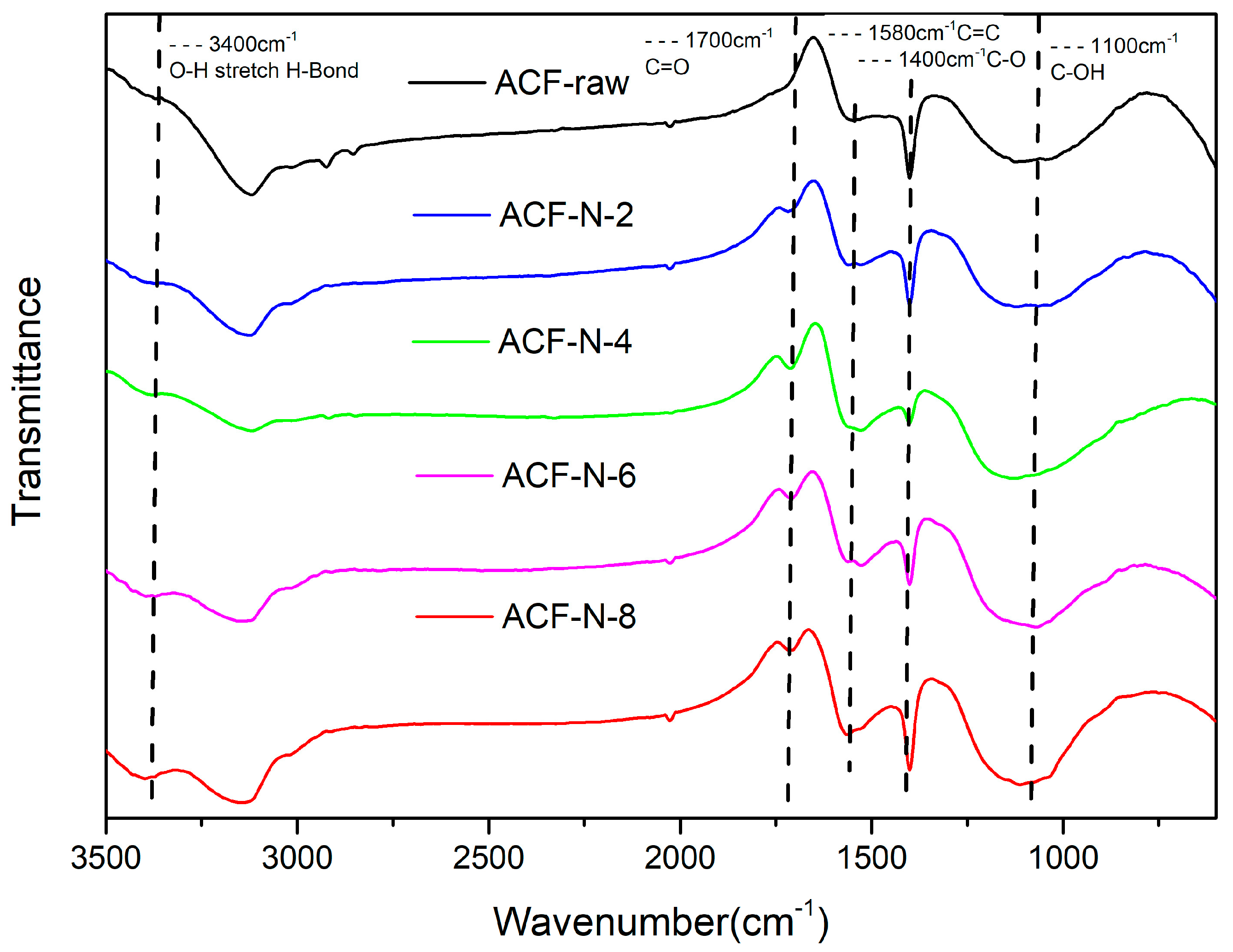
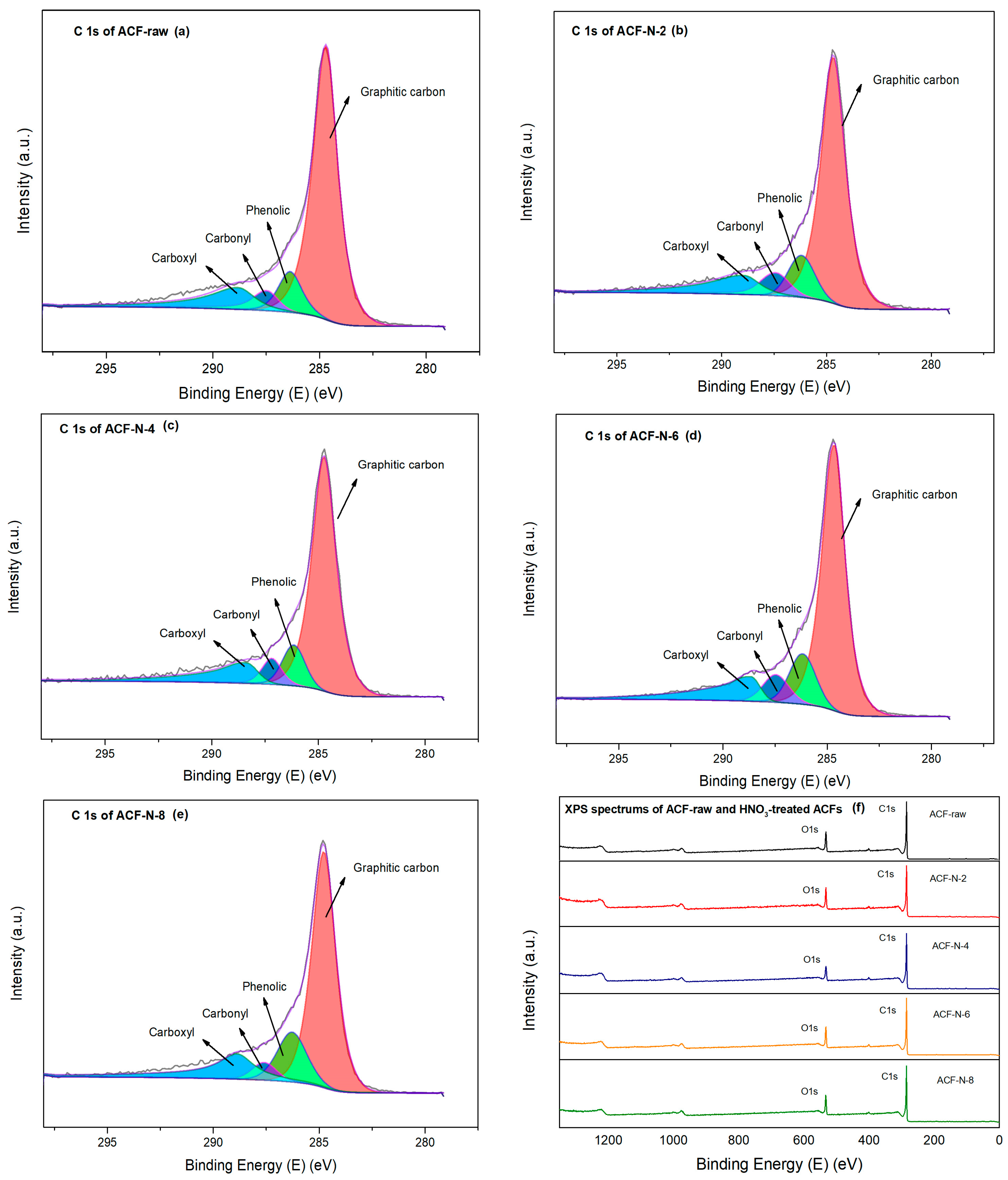
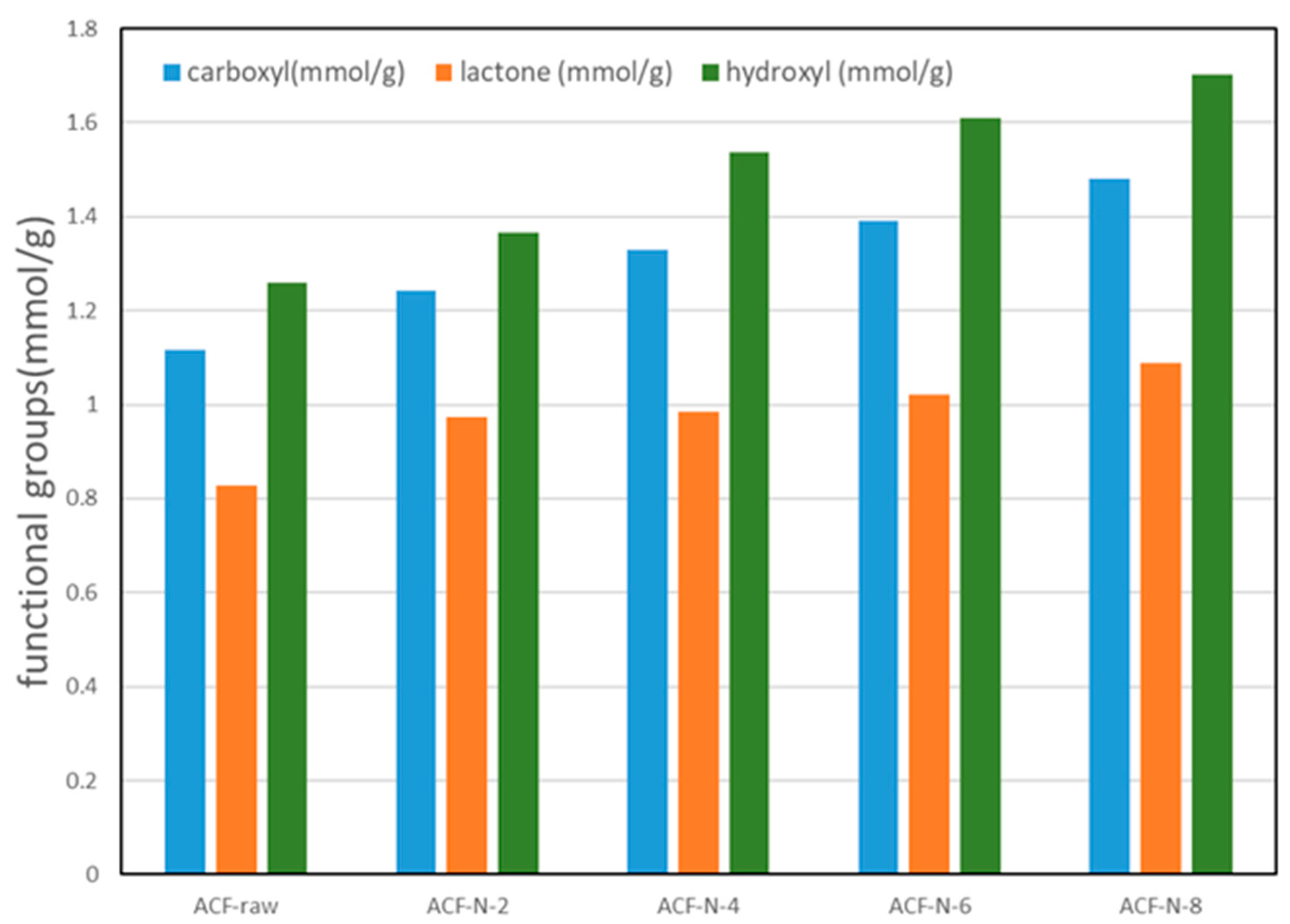
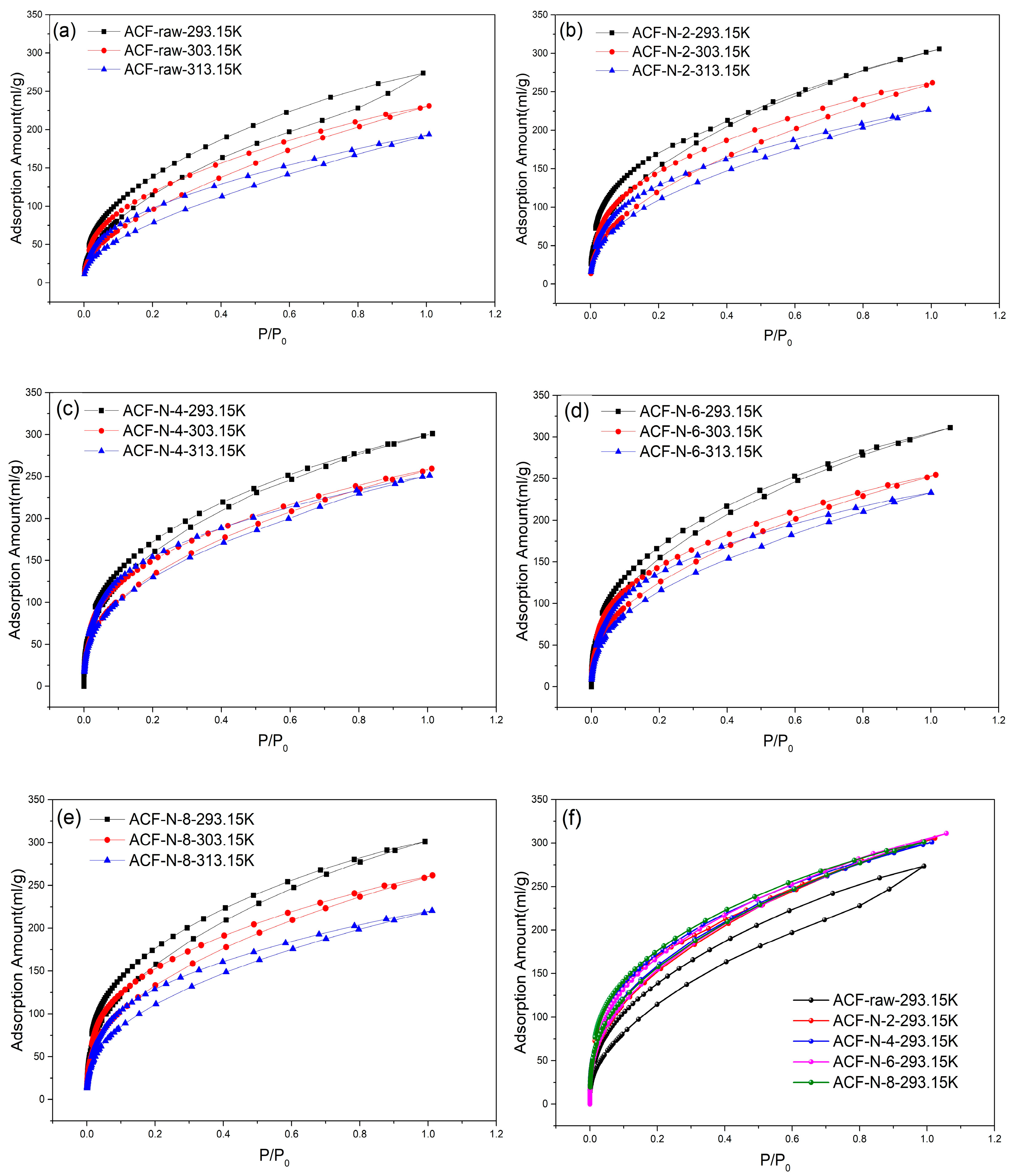
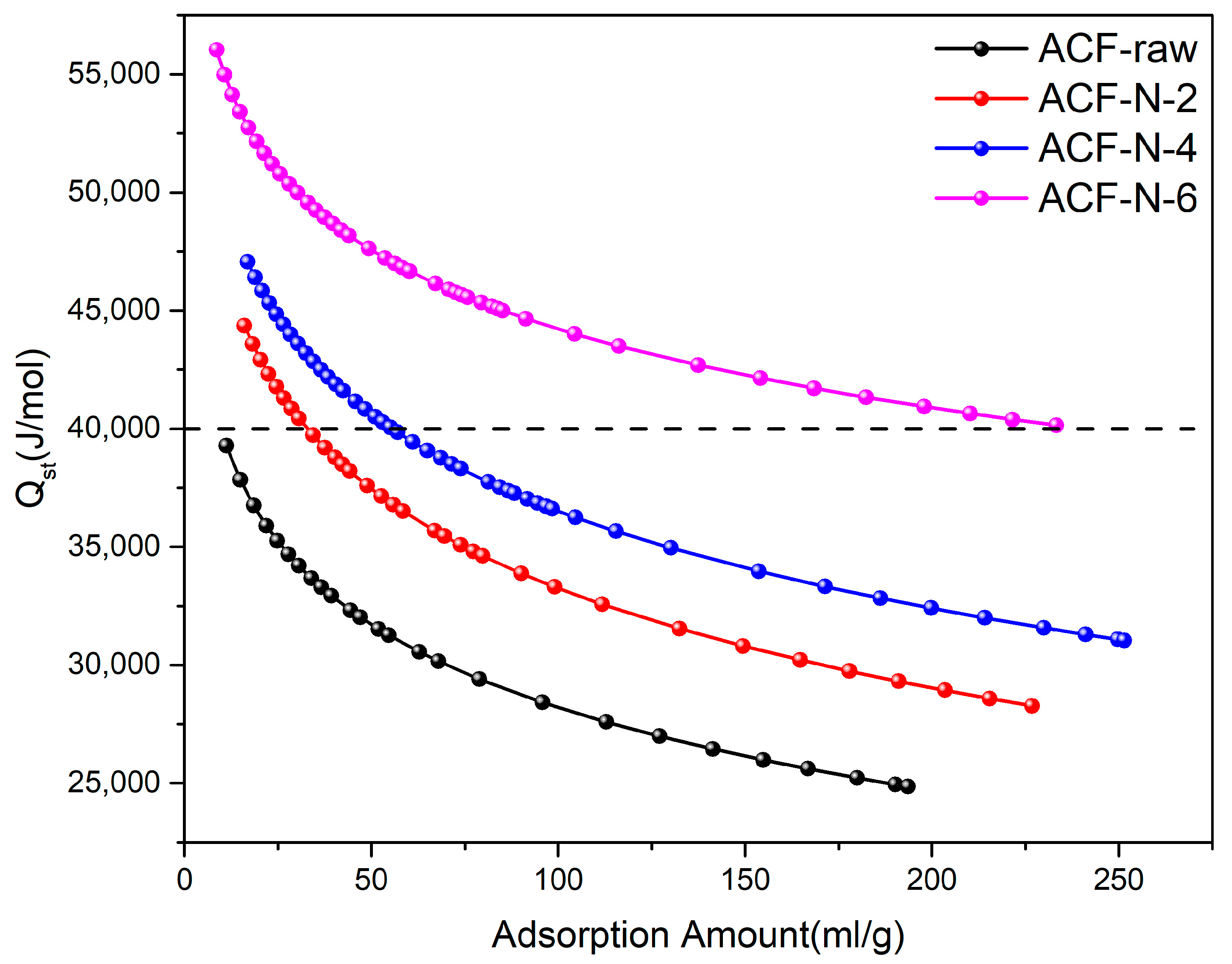

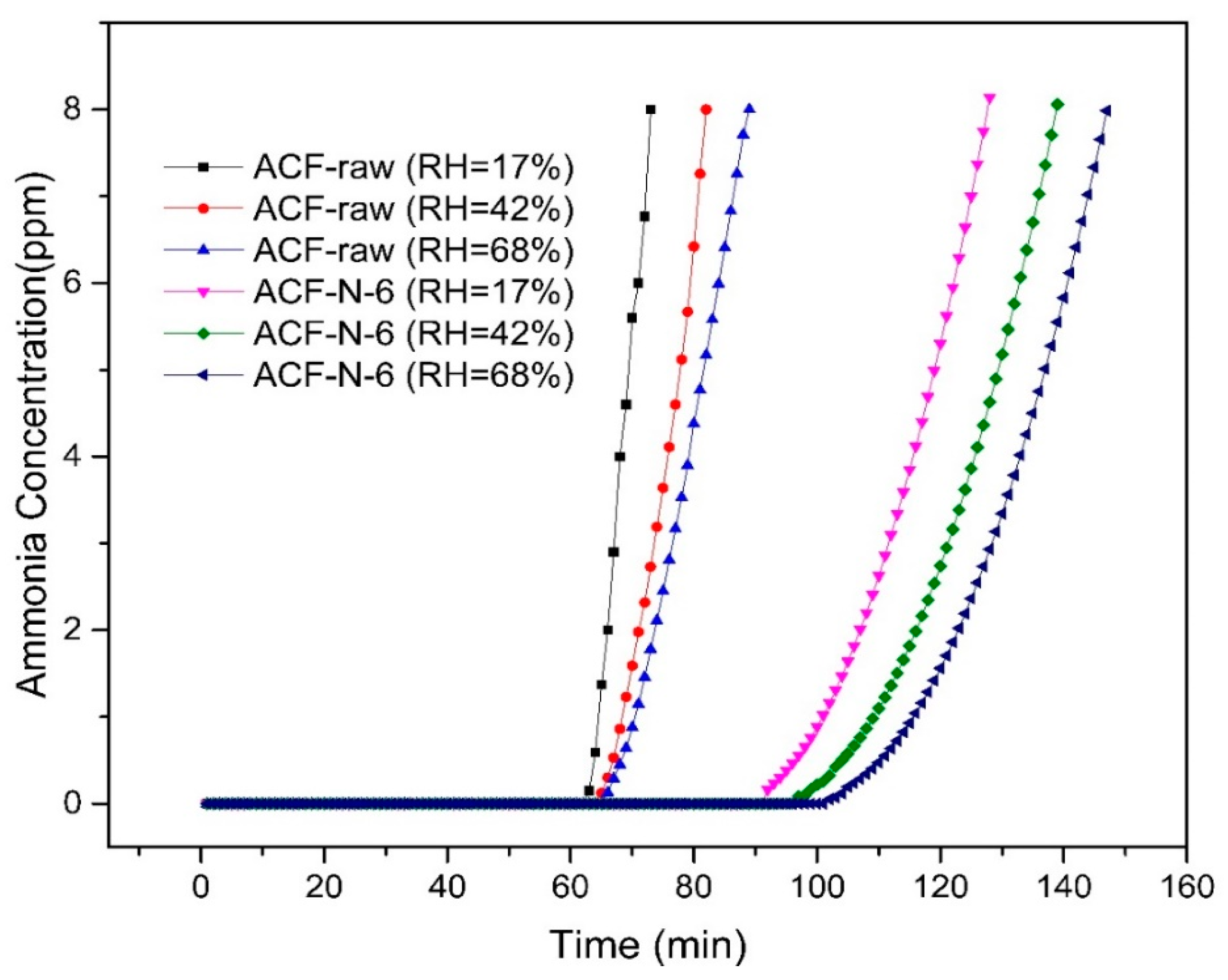
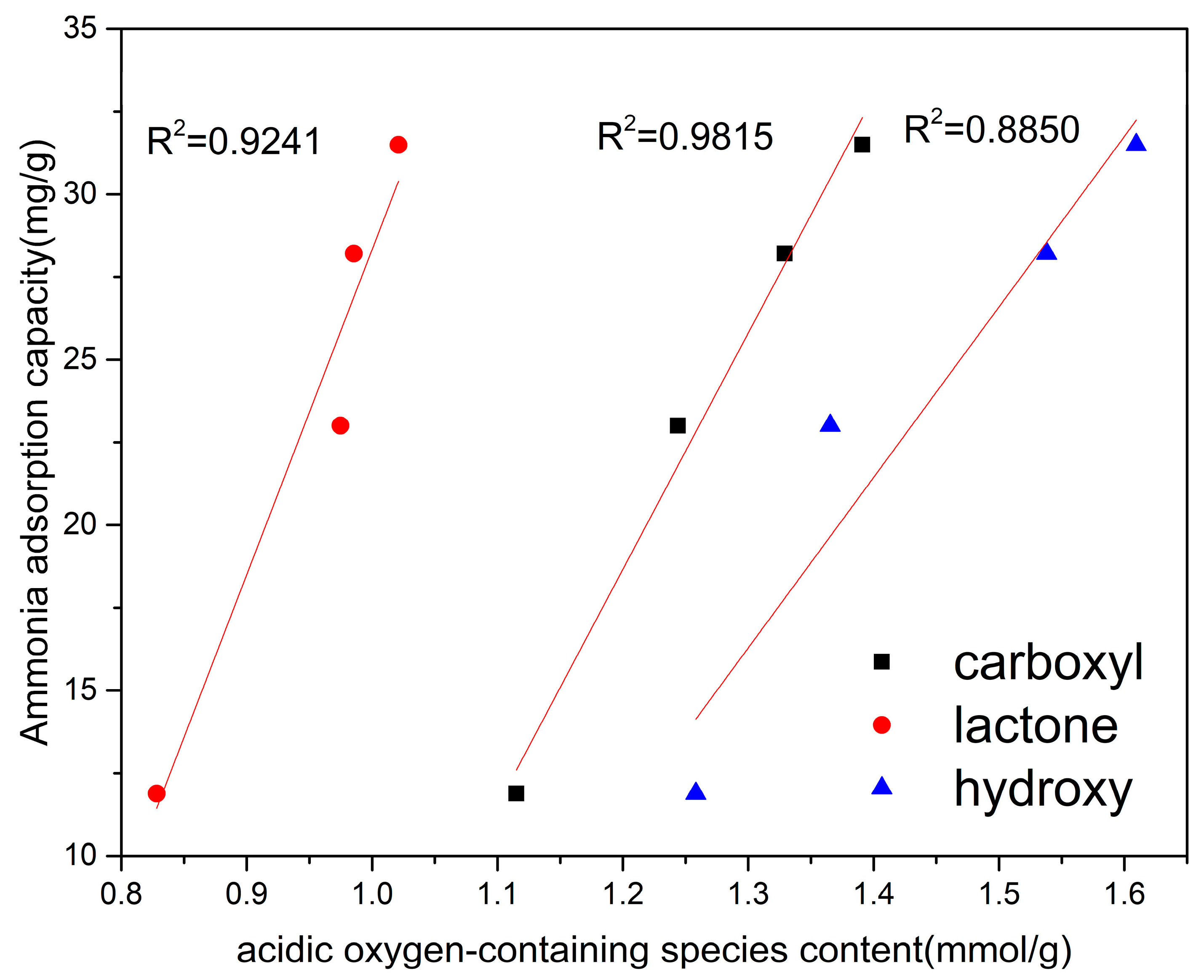
| Deconvolution % | O1s/C1s (%) | ||||
|---|---|---|---|---|---|
| C=C/C-C Peak (284.8 eV) | C-O Peak Phenolics or Ethers (286.2 eV) | C=O Peak Carbonyl (287.5 eV) | O-C=O Peak Carboxylic Acid and Its Derivatives (288.8 eV) | ||
| ACF-raw | 71.11 | 9.90 | 6.50 | 12.49 | 14.72 |
| ACF-N-2 | 68.16 | 11.29 | 8.03 | 12.51 | 16.25 |
| ACF-N-4 | 66.91 | 13.28 | 7.21 | 12.60 | 18.47 |
| ACF-N-6 | 65.65 | 13.48 | 7.26 | 13.62 | 18.92 |
| ACF-N-8 | 63.36 | 15.77 | 4.74 | 16.13 | 19.19 |
| Sample | Pore Volume (cm3·g−1) | Surface Area (m2·g−1) | dPore (nm) |
|---|---|---|---|
| ACF-raw | 0.304 | 992.6 | 0.548 |
| ACF-N-2 | 0.322 | 1033.9 | 0.548 |
| ACF-N-4 | 0.332 | 1056.4 | 0.548 |
| ACF-N-6 | 0.352 | 1121.1 | 0.548 |
| ACF-N-8 | 0.325 | 1033.2 | 0.548 |
| Material Type | Sample | NH3 Adsorption Capacity (mmol·L−1) | Reference |
|---|---|---|---|
| Activated carbon | ACF-N-6 | 14.08 | This study |
| MOF | Ga-PMOF | 10.50 | [11] |
| MOF | Co(NA)2 | 15.44 | [40] |
| Activated carbon | Doped activated carbon | 13.80 | [39] |
| Activated carbon | Mesoporous carbon beads | 6.54 | [41] |
| Zeolite | Zeolite-A | 8.39 | [42] |
| Biochar | Bamboo biochar | 6.74 | [43] |
| Nanostructured materials | [Fe2(H2opba)2Cl2(dmso)2]·2CH2Cl2·2dmso | 11.28 | [44] |
| Sample | Temperature (K) | ΔG (kJ·mol−1) | ΔH (kJ·mol−1) | ΔS (J·mol−1·K−1) |
|---|---|---|---|---|
| ACF-raw | 293.15 K | −3.28 | −33.36 | −102.545 |
| 303.15 K | −2.32 | |||
| 313.15 K | −1.23 | |||
| ACF-N-6 | 293.15 K | −6.97 | −39.87 | −112.372 |
| 303.15 K | −5.72 | |||
| 313.15 K | −4.73 |
Disclaimer/Publisher’s Note: The statements, opinions and data contained in all publications are solely those of the individual author(s) and contributor(s) and not of MDPI and/or the editor(s). MDPI and/or the editor(s) disclaim responsibility for any injury to people or property resulting from any ideas, methods, instructions or products referred to in the content. |
© 2023 by the authors. Licensee MDPI, Basel, Switzerland. This article is an open access article distributed under the terms and conditions of the Creative Commons Attribution (CC BY) license (https://creativecommons.org/licenses/by/4.0/).
Share and Cite
Niu, Y.; Zheng, C.; Xie, Y.; Kang, K.; Song, H.; Bai, S.; Han, H.; Li, S. Efficient Adsorption of Ammonia by Surface-Modified Activated Carbon Fiber Mesh. Nanomaterials 2023, 13, 2857. https://doi.org/10.3390/nano13212857
Niu Y, Zheng C, Xie Y, Kang K, Song H, Bai S, Han H, Li S. Efficient Adsorption of Ammonia by Surface-Modified Activated Carbon Fiber Mesh. Nanomaterials. 2023; 13(21):2857. https://doi.org/10.3390/nano13212857
Chicago/Turabian StyleNiu, Yongxiang, Chao Zheng, Yucong Xie, Kai Kang, Hua Song, Shupei Bai, Hao Han, and Shunyi Li. 2023. "Efficient Adsorption of Ammonia by Surface-Modified Activated Carbon Fiber Mesh" Nanomaterials 13, no. 21: 2857. https://doi.org/10.3390/nano13212857
APA StyleNiu, Y., Zheng, C., Xie, Y., Kang, K., Song, H., Bai, S., Han, H., & Li, S. (2023). Efficient Adsorption of Ammonia by Surface-Modified Activated Carbon Fiber Mesh. Nanomaterials, 13(21), 2857. https://doi.org/10.3390/nano13212857





